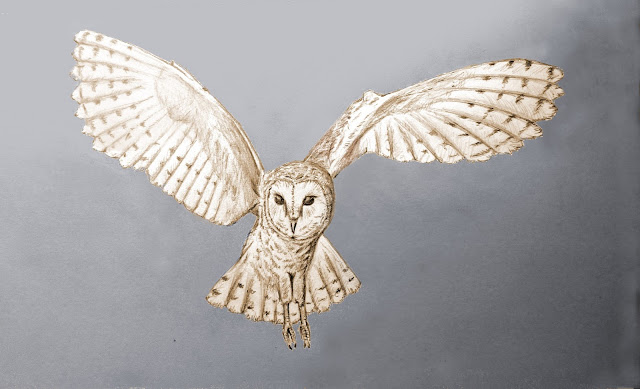Wising up on owls
 |
| I've been trying to get a good Barn Owl photo to illustrate this post. As I didn't succeed I decided to make my own picture. |
The Barn Owl is probably my favourite bird. I hardly ever saw one when I lived in Cheshire, now on my morning patch walks, I see them very regularly. I get a thrill every time.
There’s something very enigmatic about them - somehow they don’t seem to belong to quite the same dimension as everything else.
Almost as if they’ve slipped through a portal - briefly joining our world from their ghostly homeland - then returning there at the end of the night.
A hunting Barn Owl is a beautiful thing to watch - the slow motion dance of wheeling, flitting and pouncing - all with a wonderful buoyancy - a lightness of touch. I think the word 'grace' was invented for this.
Almost as if they’ve slipped through a portal - briefly joining our world from their ghostly homeland - then returning there at the end of the night.
A hunting Barn Owl is a beautiful thing to watch - the slow motion dance of wheeling, flitting and pouncing - all with a wonderful buoyancy - a lightness of touch. I think the word 'grace' was invented for this.
I collected some owl pellets from underneath a roosting place which I've been dissecting like a good’un, like an owl-based Gillian Mckeith in fact - only with pellets rather than poop.
Pellet dissection isn't the unpleasant - rummaging around in remains - you might imagine. The pellets are dry and almost odourless. However in my wisdom (which is decidedly finite) I sterilised, them with a quick blast in the microwave. This left a smell in the kitchen, that scholars of the future will probably refer to as - 'very nasty'.
The things to look out for are the lower jaw bones - each pair represents one mammal.
Those results in full:
Owl pellets are another example of something that gives us a glimpse of a world we hardly ever see. There are throngs of small mammals scurrying around in the undergrowth. In fact, as much of the patch consists of rough grassland - prime vole habitat - there could be a patch population of 20,000!
Compare this with Wrens - the patch commonest bird with about 50 breeding pairs - I very frequently see Wrens whereas I hardly ever see a vole.
Wrens inhabit a similar "sense world" to ours - voles are almost invisible to us - their's is a different domain. With their super-keen senses owls straddle both domains - they have to in order to survive.
Barn Owl pellets:
- are easy to recognise, being black and shiny often with a pointed end
- consist of bones within a matrix softer material - usually fur
- are formed when prey is swallowed whole - the food is broken up in the gizzard the indigestible parts are compacted into the pellet, the rest passes on to the stomach for digestion
- what the owl eats
- how much it eats
- what small mammals are present in the area and in what numbers
Recent Patch Sightings
18/2 - first Blackbird song (one of my highlights every year)
19/2 - Chaffinch, Goldcrest, Treecreeper, Mistle Thrush Song
20/2 - Canada Geese back at the lake - the first 'summer visitors'
18/2 - first Blackbird song (one of my highlights every year)
19/2 - Chaffinch, Goldcrest, Treecreeper, Mistle Thrush Song
20/2 - Canada Geese back at the lake - the first 'summer visitors'
 |
| Me and my shadow enjoying some morning sun and frost on the patch |





A fantastic post on these fascinating finds (I'd thought about doing a similar post!). I love your Barn owl image too - very nicely done.
ReplyDeleteWe don't do too badly for Barn owls here, they do make some use of the many boxes put up for them, but they're largely on private farmland so the birds we do have no doubt spend a lot of their time in places largely inaccessible to the public. Great to hear that you now see them frequently on your patch.
Had to laugh at your sterilising of pellets in the microwave. My family tolerate a lot of collected feathers, shells, and the occasional skull lying around but I think pellets in the microwave would land me in deep trouble! :)
Jackie and I just lol'd at your "microwave deep trouble comment", I do get occasional eyebrows raised at my antics. What used to be my 'office' I now, only half jokingly, refer to as " the lab".
DeleteRe Cheshire Barn Owls, I think there are more in Lancs but even so I used to see reports of Barn Owls in various places in Cheshire, and wondered why I never saw them. I suppose you can miss out if you go to the right place, but at the wrong time.